Complete Solutions to MULTIPLE CHOICE QUESTIONS of chapter RAY OPTICS (MIRRORS, LENSES AND OPTICAL INSTRUMENTS) of Class 11 book with complete answers and questions
| Class 11 | PHYSICS |
| Chapter | RAY OPTICS (MIRRORS, LENSES AND OPTICAL INSTRUMENTS) |
| MARVEL | MULTIPLE CHOICE QUESTIONS |
| Number Of Questions | 100 |
| Academic Year | 2023-24 |
A ray of light on a plane mirror at an angle of `60^(@)`. What is the deviation produced by the mirror ?
01:55View SolutionA plane mirror produces a magnification of
00:56View SolutionA student of height 1.9 m can see his full image in a plane mirror fixed on a wall. His eyes are 1.85 m from the floor level. What is the minimum length of the plane mirror required to get the full image of the student ?
02:20View SolutionA ray of light is incident on a plane mirror at an angle of `20^(@)` with the normal, at the point of incidence, Through what angle, the ray of light will be deviated from its direction of incidence ?
02:23View SolutionTwo plane mirrors are inclined at an angle of `60^(@)`. An object is placed between the mirrors. The number of images formed by the two mirrors is
03:09View SolutionA plane mirror is placed along the x-axis facing negative y-axis. The mirror is fixed. An object is moving with a velocity of `3hati+4hatj` in front of the plane mirror. The relative velocity of image with respect to the object is
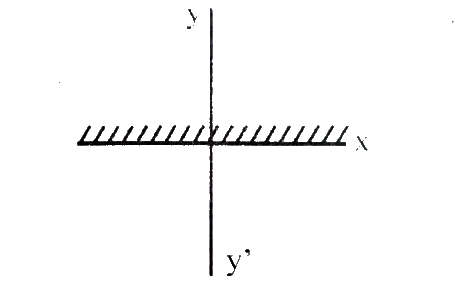 View Solution
View SolutionWhich mirror should be used to obtain a parallel beam of light from a small lamp, placed in front of the mirror ?
01:40View SolutionAn object is placed at a distance of 30 cm from the pole of a curved (convex or concave) mirror of focal length 15 cm. Then the linear magnification is
03:15View SolutionAn object is placed at 50 cm in front of a concave mirror of focal length 25 cm. What is the nature of the image produced by the mirror ?
02:13View SolutionA concave mirror of focal length 15 cm forms an image having twice the linear dimensions of the object. The position of the object when the image is virtual will be
03:42View SolutionA boy stands straight in front of a mirror at a distance of 30 cm from it. He sees his erect image whose height is `(1)/(5)` of his real height. The mirror he is using is
02:28View SolutionA 4.5 cm object is placed perpendicular to the axis of a convex mirror of focal length 15 cm at a distance of 12 cm. The size of the image is
03:25View SolutionWhat is the distance of an object from a concave mirror of focal length 20 cm so that the size of the real image is three times the size of the object ?
02:16View SolutionA spherical mirrorr forms an image of magnification 3. The object distance, if focal length of mirrorr is `24cm,` may be
04:35View SolutionImage of an object approaching a convex mirror of radius of curvature 20m slong its optical axis is observed to move from `(25)/(3)`m to `(50)/(7)`m in 30 seconds. What is the speed of the object in km per hour?
02:55View SolutionA candle flame 3 cm high is placed at a distance of 3m from a wall. How far from the wall must a concave mirror be placed so that it may form 9 cm high image of the flame on the same wall ? Also find the focal length of the mirror.
01:52View SolutionThe focal length of a concave mirror is 10 cm. An L- shaped object is placed in front of the mirror as shown. The dimension of L along the horizontal is 2 cm and along the vertical is 4 mm. What is the magnification of the image along the axis ?
 View Solution
View SolutionThe focal length of convex lens is 30 cm and the size of image is quarter of the object, then the object distance is
01:20View SolutionFocal length of convex lens will miximum for
01:18View SolutionAn air lens having `R_(1)=R_(2)=10` cm is cut in a glass slab of `mu=1.5`. What is the focal length and the nature of the lens ?
View SolutionA concave lens having a material of refractive index `mu_(1)` is kept in a medium of R.I. `mu_(2)`, where `mu_(1) lt mu_(2)`. A parallel beam of light is incident on the lens. The concave lens will act as
01:49View SolutionA luminous point object is placed at a distance of 20 cm, from the pole of a convex spherical surface of glass. The radius of the curvature of the convex surface is 25 cm and the R.I. of the glass is 1.5. What is the distance of the image from its pole ?
03:18View SolutionThe radii of curvature of the two surface of a double convex glass lens are 10 cm and 20 cm respectively. If the refractive index of glass in 1.5, then its focal length will be
01:58View SolutionHow far from a convex lens of focal length 20 cm would you place an object to get a real image enlarged three times ?
03:09View SolutionAn object of height 10 cm is placed at the focus of a concave lens. What is the height of the image ?
02:59View SolutionHow far from a convex lens of focal length 20 cm would you place an object to get a virtual image, which is magnified 3 times ?
05:12View SolutionA projector lens has a focal length of 10 cm. It produces a real image of a `2cm xx 2 cm` slide on a screen 5 metre from the lens. What is the size of the picture on the screen ?
04:33View SolutionIf the radii of curvature of the two surfaces of a concave lens are 10 cm and 20 cm respectively and the refractive index is 1.5. What is its focal length ?
01:16View SolutionThe refractive index and the focal length of a plano convex lens are 1.5 and 50 cm respectively. What is the radius of curvature of the curved surface ?
02:16View SolutionThe plane faces of two identical planoconvex lenses each having focal length of `40 cm` are pressed against each other to form a usual convex lens. The distance from this lens, at which an object must be placed to obtain a real, inverted image with magnification one is
03:28View SolutionAt what distance an object must be placed from a lens of focal length 15 cm to get an inverted image of unit magnification ?
04:37View SolutionA double convex lens whose radii of curvature are `R_(1)` and `R_(2)` forms the image of a point object, placed on its axis. If the lens is revered, face to face, then the ratio of the distances of the images in the first and second case will be
01:15View SolutionAn object is placed at a distance of 30 cm from a concave lens of focal length 15 cm. What is the height of the object if the height of the image is 3 cm ?
01:30View SolutionA convex lens is dipped in a liquid whose refractive index is equal to the refractive of the lens. Then its focal length will
03:03View SolutionAn object placed at 20 cm from a lens, forms an image on a screen placed 60 cm on the other side of the lens. What is the focal length and type of the lens ?
02:11View SolutionA long glass rod has a hemispherical end. A narrow beam of light is incident on the spherical end, the beam being parallel to the length of the rod. What is the position of the image formed if the refractive index of glass is 1.5 and the radius of curvature of the spherical surface is 10 cm ?
05:15View SolutionA plano-convex lens is made of glass of refractive index 1.6. the radius of curvature of its curved surface is 30 cm. What is the focal length of the lens ?
01:46View SolutionA convex glass lens of focal length 20 cm and refractive index 1.5 is immersed in water of R.I. `4//3`. What is the change in its focal length ?
02:21View SolutionA convex lens is made up of three different transparent materials as shown in the figure. How many real images arc formed, if a point object is placed on its principal axis ?
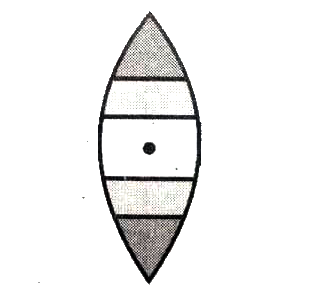 View Solution
View SolutionLet `f_(v)` and `f_(r)` are the focal lengths of a convex lens for violet and red lights respectively. If `F_(v)` and `F_(r)` are the focal lengths of a concave lens for violet and red light respectively, then
03:54View SolutionA body is located on a wall. Its image of equal size is to be obtained on a parallel wall with the help of a convex leng. The lens is placed at a distance d ahead of second wall, then the required focal length will be:
02:17View SolutionIn displacement method, the lengths of images in the two positions of the lens betwent the object and the screen are 9 cm and 4 cm respectively. The length of the object must be
01:16View SolutionA lens if placed between a source of light and a wall. It forms images of area` A_(1)` and `A_(2)` on the wall for its two different positions. The area of the source or light is
05:27View SolutionThe medium on both of a lens is air. The distances of the object O and the image I from first and second foci `F_(1)` and `F_(2)` are 9 cm and 16 cm respectively. What is the focal length of lens ?
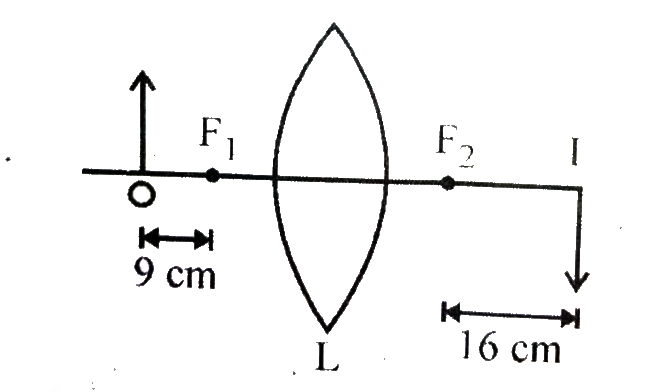 View Solution
View SolutionAn index pin of height 3 cm is kept at a distance of 15 cm from a convex lens of focal length 10 cm. The image is obtained on a screen placed on the other side of the lens. What is the height and nature of the image ?
02:01View SolutionAn object is placed in front of convex lens. If the central portion of a convex lens is painted black as shown in the figure, then
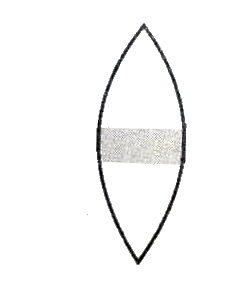 View Solution
View SolutionThe lower half of a convex lens is painted black. If an object is placed in front of the lens, then
01:41View SolutionThe real iamge of a square hole in screen, illuminated be light is obtained on another screen with the help of a converging lens. This distance of the hole from the lens is 20 cm. the are of the image is nine times that of the hole. What is the focal length of the lens ?
01:44View SolutionAn illuminated object and a screen are placed `90 cm` apart. What is the focal length and nature of the lens required to produce a clear image on the screen twice the size of the object ?
03:33View SolutionFocal length of convex lens will miximum for
01:18View SolutionThe refractive indices of the material of a lens for violet, yellow and red colours of light are 1.66, 1.64 and 1.62 respectively. The mean focal length of the lens is 10 cm. What is the chromatic aberration of the lens between the violet and the red colours ?
01:37View SolutionThe image of an illuminated square object is obtained on a screen with the help of a converging lens. The distance of the square from the lens is 30 cm. The area of the image is 9 times of the square. What is the focal length of the ions ?
01:43View SolutionA double convex lens of focal length 6 cm is made of glass of refractive index 1.5. The radius of curvature of one surface is double that of the other surface. The value of smaller radius of curvature is
01:18View SolutionWhat is the refractive index of material of a plano-convex lens , if the radius of curvature of the convex surface is 10 cm and focal length of the lens is 30 cm ?
01:09View SolutionAn object is placed at the focus of a concave lens. Where will be image ?
01:37View SolutionA convex lens has the same radius of curvature (R ) for both the surfaces. For what value of the refractive index of the material of the convex lens, the numerical values of f and R are equal ?
01:21View SolutionAn equiconvex lens has a focal length f. It is cut into two equal parts along the dotted line as shown in the figure. What will be the focal length of each part ?
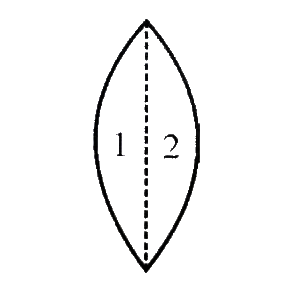 View Solution
View SolutionAn object is placed at a distance `x_1` from the principal focus of a lens and its real image is formed at a distance `x_2` from the another principal focus. The focal length of the lens is
02:11View SolutionWhen a biconvex lens of glass having refractive index `1.47` is dipped in a liquid, it acts as a plane sheet of glass. This implies that the liquid must have refractive index.
03:37View SolutionA double convex thin lens made of glass (refractive index `mu = 1.5`) has both radii of curvature of magnitude 20 cm . Incident light rays parallel to the axis of the lens will converge at a distance L such that
02:52View SolutionA double convex lens has faces of radii of curvature 30 cm each. The refractive index of the material of the lens is 1.5. What is the focal length of this lens when immersed is carbondisulphide of refractive index 1.6 ?
01:58View SolutionThe radii of curvature of a double concave lens are 30 cm and 45 cm. What is its focal length in water ?
`[""_(a)n_(g)=1.5, ""_(a)n_(w)=4//3]`01:45View SolutionA source of light and a screen are placed 90 cm apart. Where should a convex lens of 20 cm focal length be placed in order to form a real image of the source on the screen ?
02:23View SolutionA convex lens of focal length `f` produces a virtual image `n` times the size of the object. Then the distance of the object from the lens is
03:00View SolutionAn aircraft flying at a altitude of 2000 metre, takes the photographs of the ground by a camera with a lens of focal length 0.5 m. The size of the film in the camera is `12 cm xx 12 cm`. What area of the ground can be photographed by this camera at any time ?
04:29View SolutionIf `f(V)` and `f_(R)` are the focal lengths of a concex lens for violet and red light respectively and `F_(V)`and `F_(R)` are the focal lengths of concave lens for violet and red light respectively, then we have
02:18View SolutionTwo plano-convex lenses of radii of curvature R and R and refractive index 1.5 will have equivalent focal length equal to R, if they are placed
02:13View SolutionAn equiconvex lens is cut into two halves along (i) XOX' and (ii) YOY' as shown in the figure. Let f, f, f' be the focal lengths of the complete lens, of each half in case (i), and of each half in case (ii), respectively.
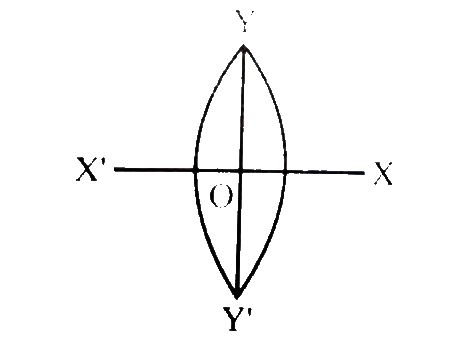
Choose the correct statement from the following.View SolutionA boy is trying to start a fire by focusing sunlight on a piece of paper using an equiconvex lens of focal length `10cm`. The diameter of the sun is `1.39xx10^(9)m` and its mean distance from the earth is `1.5xx10^(11)m`. What is the diameter of the sun's image on the paper ?
03:46View SolutionA concave lens of glass, refractive index 1.5 has both surfaces of same radius of curvature R. On immersion in a medium of refractive index 1.75, it will behave as a
04:15View SolutionAn object is placed first at infinity and then at 20 cm from the object side focal plane of a convex lens. The two images thus formed are 5 cm apart the focal length of the lens is
02:38View SolutionThe magnification of the real images produced by a convex lens varies from one to infinity. What are the values of the distances of the object from the lens for these magnifications ?
04:27View SolutionA thin convex lens of focal length f, has its aperture of diameter d. It forms a real iomage of intensity I. The central part of the aperture is blocked by an opaque paper of diameter `(d)/(2)`. What is the focal length of the lens and the intensity of image formed by the lens ?
02:33View SolutionFor an optical arrangement shown in the figure, what is the position of the image formed ?
 View Solution
View SolutionThe divergent lens in m linear magnification produced by the lens is
02:45View SolutionAn eye specialist prescribes spectacles having combination of convex lens of focal length 40cm in contact with a concave lens of focal length 25cm. The power of this lens combination in diopters is
01:45View SolutionA convex lens and a concave lens are kept separated by a distance d. If they are placed in close contact, the focal length of the combination
04:09View SolutionTwo lenses with powers +12D and -2D are kept in close contact with each other. Find the power and the focal length of the combination.
02:07View SolutionA convex lens of focal length 25 cm is kept is contact with a concave lens of focal length 40 cm. What is the power of their combination ?
03:12View SolutionThe focal length of the combination of two thin lenses in contact is 80 cm. If the focal length of one lens is -20 cm, what is the power of the other lens ?
02:56View SolutionThe radius of curvature of the convex surface of a thin plano-convex lens is 12 cm, and the refractive index of its material is 1.6. What is the power of lens ?
02:45View SolutionThe focal length of a glass convex lens of refractive index 1.5 is 20 cm. What is the focal power of the lens when immersed in a liquid of refractive index of 1.25 ?
03:54View SolutionA convex lens of focal length 80 cm and a concave lens of focal length 50 cm are combined toghether. What will be their resulting power ?
01:44View SolutionA convex lens and a concave lens, each having same focal length of `25 cm`, are put in contact to form a combination of lenses. The power in diopters of the combination is
03:43View SolutionTwo thin convex lenses of focal lengths `f_(1)` and `f_(2)` are in contact and coaxial. The power of the combination is
02:17View SolutionAn achromatic combination of lenses is to be made by using a convex and a concave lens. The two lenses should have
03:34View SolutionTwo thin lenses of powers 2D and 4D are placed in close contact. An object is placed at a distance of 50 cm from the combination. What is the distance of the image from the combined lens ?
07:23View SolutionA lens of power +3.5D is placed in contact with a lens of power -2.5 D. The combination will behave like
06:00View SolutionTwo thin lenses of power `+ 6 D and - 2 D` are in contact. What is the focal length of the combination ?
01:30View SolutionA student's near point is 0.5 m and far point is 3m . What are the powers of the spectacle lenses required for (a) reading the books and (b) seeing the distant objects ?
05:47View SolutionA man suffering from short sight is unable to see objects distinctly at a distance greater than 2 m. The power of lens required to correct this deffect should be
03:20View SolutionThe near point of hypermetropic eye is 40 cm . What is the power of the lens used to correct this defect ?
07:16View SolutionThe real image produced by a convex lens is magnified 4 times. What is the focal power of the lens, if the distance between the object and the image is 50 cm ?
08:18View SolutionThe radii of curvature of both the surfaces of a convex lens are equal. One of the surfaces is made plane by grinding. What is the new focal power of the lens ?
10:32View SolutionA convex lens of glass `(n=(3)/(2))` has a focal length 20 cm. The lens is immersed in water of refractive index `(4)/(3)`. What is the change in the power of convex lens ?
07:06View SolutionAn object kept at a distance of 30 cm from a lens, has its image formed at 20 cm from the lens and on the same side as the object. What is the focal power of the lens ?
07:11View SolutionA real image is formed by a convex lens. If we put a concave lens in contact with it, the combination again forms a real image. The new image
03:05View SolutionThe magnifying power of simple microscope can be increased if we use a lens of
01:56View SolutionWhat is the magnifying power of a simple microscope of focal length 5 cm, if the image is formed at the distance of distinct vision ?
01:42View SolutionA simple microscope has a magnifying power of 4.125, when the image is formed at the distance of distinct vision. What is the focal power of the lens ?
03:00View Solution
MULTIPLE CHOICE QUESTIONS questions and complete solutions for chapter RAY OPTICS (MIRRORS, LENSES AND OPTICAL INSTRUMENTS) of MARVEL PHYSICS (HINGLISH) of Class 11
